2-Substituted-3-(5-Substituted-1,3,4-oxadiazol/thiadiazol-2-yl) Thiazolidin-4-one Derivatives: Synthesis, Anticancer, Antimicrobial, and Antioxidant Potential
Abstract
:1. Introduction
2. Results
2.1. Antimicrobial Evaluation
2.2. MTT Assay Evaluation
2.3. Antioxidant Evaluation
2.4. Structure–Activity Relationship
- The differences in the substitution and presence of the pharmacophore ring in the final thiazolidin-4-one derivatives of the 1,3,4-oxadiazole/thiadiazole ring played a crucial role in improving the overall biological potential.
- The presence of an electron-donating group (-OCH3/OH) at the para position in the synthesized compound D-16 increased the anticancer and antioxidant potential.
- The presence of electron-withdrawing groups (Cl/Br) at the para position in the synthesized compound D-4 increased the antimicrobial potential against all Gram-(+ve) and Gram-(−ve) bacterial strains, as well as fungal strains.
- The electron-withdrawing group (-Cl/Br) at the para position in the synthesized compounds D-1 and D-20 increased the antifungal potential against Aspergillus niger.
- The presence of an electron-donating group (-OCH3) at the para position increased the antifungal potential against Trichoderma harzianum in the synthesized compounds D-8 and D-11.
- The electronegative group bromo (Br) in the synthesized compounds D-17 and D-20 enhanced the antibacterial activity against S. aureus and K. pneumoniae, as well antifungal activity against A. niger.
- Further, these molecules can serve as compounds to create novel antimicrobial and anticytotoxic drugs that are more potent and less toxic.
3. Discussion
4. Materials and Methods
4.1. Chemistry
- Step 1: Synthesis of substituted 2-amino 1,3,4-oxa/thia(azoles) (03) [30].
- Step 2: General procedure for synthesis of Schiff bases (5).
- Step 3: General procedure for synthesis of 2-substituted-3-(5-substituted-1,3,4-oxa/thiadiazol-2-yl) thiazolidin-4-one (7).
4.2. Biological Procedure
4.2.1. MTT Assay
4.2.2. In Vitro Antioxidant Assay
4.2.3. In Vitro Antimicrobial Assay
5. Conclusions
Supplementary Materials
Author Contributions
Funding
Institutional Review Board Statement
Informed Consent Statement
Data Availability Statement
Acknowledgments
Conflicts of Interest
Abbrevations
| MIC | Minimum inhibitory concentration |
| MW | Molecular weight |
| IC50 | Half-maximal inhibitory concentration |
| µM | Micromolar |
| M.pt. | Melting point |
References
- Deep, A.; Kumar, D.; Bansal, N.; Narasimhan, B.; Marwaha, R.K.; Sharma, P.C. Understanding Mechanistic Aspects and Therapeutic Potential of Natural Substances as Anticancer Agents. Phytomedicine Plus 2023, 3, 100418. [Google Scholar] [CrossRef]
- Huang, Z.; Yang, M. Molecular Network of Colorectal Cancer and Current Therapeutic Options. Front. Oncol. 2022, 12, 852927. [Google Scholar] [CrossRef] [PubMed]
- Beniwal, M.; Jain, N.; Jain, S.; Aggarwal, N. Design, Synthesis, Anticancer Evaluation and Docking Studies of Novel 2-(1-Isonicotinoyl-3-Phenyl-1H-Pyrazol-4-Yl)-3-Phenylthiazolidin-4-One Derivatives as Aurora-A Kinase Inhibitors. BMC Chem. 2022, 16, 61. [Google Scholar] [CrossRef] [PubMed]
- Chopra, N.; Jain, S.; Aggarwal, N. Comparative In Vitro Anticancer Study of 4- Thiazolidinone Scaffold Bearing Thiadiazole Moiety Derived from Phenolic Aldehydes. Int. J. Pharm. Res. 2021, 15. [Google Scholar] [CrossRef]
- Kumar, D.; Judge, V.; Narang, R.; Sangwan, S.; de Clercq, E.; Balzarini, J.; Narasimhan, B. Benzylidene/2-Chlorobenzylidene Hydrazides: Synthesis, Antimicrobial Activity, QSAR Studies and Antiviral Evaluation. Eur. J. Med. Chem. 2010, 45, 2806. [Google Scholar] [CrossRef]
- Goel, A.; Aggarwal, N.; Jain, S. Novel Methodology for Synthesis and Computational Analysis of Zinc Complexes of Isatin Derivatives and Screening their Biological Activity. Anti-Infect. Agents 2022, 20, e070622205691. [Google Scholar] [CrossRef]
- D’Agata, E.M.C.; Dupont-Rouzeyrol, M.; Magal, P.; Olivier, D.; Ruan, S. The Impact of Different Antibiotic Regimens on the Emergence of Antimicrobial-Resistant Bacteria. PLoS ONE 2008, 3, e4036. [Google Scholar] [CrossRef]
- Morehead, M.S.; Scarbrough, C. Emergence of Global Antibiotic Resistance. Prim. Care—Clin. Off. Pract. 2018, 45, 467–484. [Google Scholar] [CrossRef]
- Sharma, R.K.; Bibi, S.; Chopra, H.; Khan, M.S.; Aggarwal, N.; Singh, I.; Ahmad, S.U.; Hasan, M.M.; Moustafa, M.; Al-Shehri, M.; et al. In Silico and In Vitro Screening Constituents of Eclipta alba Leaf Extract to Reveal Antimicrobial Potential. Evid.-Based Complement. Altern. Med. 2022, 2022, 3290790. [Google Scholar] [CrossRef]
- Tiwari, D.; Narang, R.; Sudhakar, K.; Singh, V.; Lal, S.; Devgun, M. 1,3,4-Oxadiazole Derivatives as Potential Antimicrobial Agents. Chem. Biol. Drug Des. 2022, 100, 1086–1121. [Google Scholar] [CrossRef]
- Capoci, I.R.G.; Sakita, K.M.; Faria, D.R.; Rodrigues-Vendramini, F.A.V.; Arita, G.S.; de Oliveira, A.G.; Felipe, M.S.; Maigret, B.; Bonfim-Mendonça, P.D.S.; Kioshima, E.S.; et al. Two New 1,3,4-Oxadiazoles with Effective Antifungal Activity Against Candida albicans. Front. Microbiol. 2019, 10, 2130. [Google Scholar] [CrossRef] [PubMed]
- Glomb, T.; Świątek, P. Antimicrobial Activity of 1,3,4-Oxadiazole Derivatives. Int. J. Mol. Sci. 2021, 22, 6979. [Google Scholar] [CrossRef] [PubMed]
- Rana, K.; Salahuddin; Sahu, J.K. Significance of 1,3,4-Oxadiazole Containing Compounds in New Drug Development. Curr. Drug Res. Rev. 2021, 13, 90–100. [Google Scholar] [CrossRef]
- Kumar, D.; Kumar, V.; Kumar, H.; Deep, A.; Kumar Marwaha, R. 1,3,4-Oxadiazole as an Emerging Telomerase Inhibitor-a Promising Anticancer Motif. Cancer Adv. 2022, 5, e22018. [Google Scholar] [CrossRef]
- Kumar, D.; Kumar, H.; Deep, A.; Kumar Marwaha, R. An Updated Study of Traditional Medicines to the Era of 1,3,4 Oxadiazole Derivatives for Malaria Treatment. Tradit. Med. Res. 2023, 8, 5. [Google Scholar] [CrossRef]
- Aggarwal, N.; Jain, S. A Synthetic Approach, Characterization and Biological Evaluation of Novel 5-(Arylidene)-2-(5-methyl-1,3,4-thiadiazol-2-ylimino)thiazolidin-4-one Derivatives. Asian J. Chem. 2021, 33, 1530–1536. [Google Scholar] [CrossRef]
- Aggarwal, N.; Jain, S.; Chopra, N. Hybrids of Thiazolidin-4-Ones and 1,3,4-Thiadiazole: Synthesis and Biological Screening of a Potential New Class of Acetylcholinesterase Inhibitors. Biointerface Res. Appl. Chem. 2022, 12, 2800–2812. [Google Scholar] [CrossRef]
- Ergena, A.; Rajeshwar, Y.; Solomon, G. Synthesis and Diuretic Activity of Substituted 1,3,4-Thiadiazoles. Scientifica 2022, 2022, 3011531. [Google Scholar] [CrossRef]
- Anthwal, T.; Nain, S. 1,3,4-Thiadiazole Scaffold: As Anti-Epileptic Agents. Front. Chem. 2022, 9, 1011. [Google Scholar] [CrossRef]
- Kokovina, T.S.; Gadomsky, S.Y.; Terentiev, A.A.; Sanina, N.A. A Novel Approach to the Synthesis of 1,3,4-Thiadiazole-2-Amine Derivatives. Molecules 2021, 26, 5159. [Google Scholar] [CrossRef]
- Jain, A.K.; Sharma, S.; Vaidya, A.; Ravichandran, V.; Agrawal, R.K. 1,3,4-Thiadiazole and Its Derivatives: A Review on Recent Progress in Biological Activities. Chem. Biol. Drug Des. 2013, 81, 557–576. [Google Scholar] [CrossRef] [PubMed]
- Zabiulla; Nagesh Khadri, M.J.; Bushra Begum, A.; Sunil, M.K.; Khanum, S.A. Synthesis, Docking and Biological Evaluation of Thiadiazole and Oxadiazole Derivatives as Antimicrobial and Antioxidant Agents. Results Chem. 2020, 2, 100045. [Google Scholar] [CrossRef]
- Kumar Gupta, J.; Kumar Yadav, R.; Dudhe, R.; Kumar Sharma, P. Recent Advancements in the Synthesis and Pharmacological Evaluation of Substituted 1,3,4-Thiadiazole Derivatives. ChemInform 2010, 41, 1493–1507. [Google Scholar]
- Kumar, H.; Aggarwal, N.; Marwaha, M.G.; Deep, A.; Chopra, H.; Matin, M.M.; Roy, A.; Emran, T.B.; Mohanta, Y.K.; Ahmed, R.; et al. Thiazolidin-2,4-Dione Scaffold: An Insight into Recent Advances as Antimicrobial, Antioxidant, and Hypoglycemic Agents. Molecules 2022, 27, 6763. [Google Scholar] [CrossRef]
- Kumar, D.; Aggarwal, N.; Deep, A.; Kumar, H.; Chopra, H.; Marwaha, R.K.; Cavalu, S. An Understanding of Mechanism-Based Approaches for 1,3,4-Oxadiazole Scaffolds as Cytotoxic Agents and Enzyme Inhibitors. Pharmaceuticals 2023, 16, 254. [Google Scholar] [CrossRef]
- Kumar, D.; Kumar, H.; Kumar, V.; Deep, A.; Sharma, A.; Marwaha, M.G.; Marwaha, R.K. Mechanism-Based Approaches of 1,3,4 Thiadiazole Scaffolds as Potent Enzyme Inhibitors for Cytotoxicity and Antiviral Activity. Med. Drug Discov. 2023, 17, 100150. [Google Scholar] [CrossRef]
- Caneschi, W.; Enes, K.B.; Carvalho de Mendonça, C.; de Souza Fernandes, F.; Miguel, F.B.; da Silva Martins, J.; le Hyaric, M.; Pinho, R.R.; Duarte, L.M.; Leal de Oliveira, M.A.; et al. Synthesis and Anticancer Evaluation of New Lipophilic 1,2,4 and 1,3,4-Oxadiazoles. Eur. J. Med. Chem. 2019, 165, 18–30. [Google Scholar] [CrossRef]
- Mickevičius, V.; Vaickelionienė, R.; Sapijanskaitė, B. Synthesis of Substituted 1,3,4-Oxadiazole Derivatives. Chem. Heterocycl. Compd. 2009, 45, 215–218. [Google Scholar] [CrossRef]
- Kumar, D.; Kumar, H.; Deep, A.; Kumar, S.; Kumar Marwaha, R. Synthesis, Antimicrobial And Antioxidant Potential of 2-(Substituted phenyl)-3-(5-(Furan-2-Yl)-1,3,4-Oxadiazol-2-Yl) Thiazolidin-4-One Conjugates. J. Pharm. Negat. Results 2022, 13, 3409–3425. [Google Scholar] [CrossRef]
- Niu, P.; Kang, J.; Tian, X.; Song, L.; Liu, H.; Wu, J.; Yu, W.; Chang, J. Synthesis of 2-Amino-1,3,4-Oxadiazoles and 2-Amino-1,3,4-Thiadiazoles via Sequential Condensation and I2-Mediated Oxidative C-O/C-S Bond Formation. J. Org. Chem. 2015, 80, 1018–1024. [Google Scholar] [CrossRef]
- Kumar, D.; Aggarwal, N.; Kumar, V.; Kumar, H.; Deep, A.; Bibi, S.; Chopra, H.; Kumar Marwaha, R.; Alshammari, A.; Alharbi, M.; et al. Synthesis, Anticancer, Antimicrobial and Antioxidant Potential of Novel 4-(Substituted phenyl-1,3,4-oxadiazol/thiadiazol-2-yl)-4-(4- substituted phenyl) Azetidin-2-One Derivatives. Pharmaceuticals 2023, 16, 517. [Google Scholar] [CrossRef] [PubMed]
- Deshpande Laboratories Bhopal. Available online: http://deshpandelab.com/ (accessed on 18 February 2023).
- Sebaugh, J.L. Guidelines for Accurate EC50/IC50 Estimation. Pharm. Stat. 2011, 10, 128–134. [Google Scholar] [CrossRef] [PubMed]
- Mravljak, J.; Slavec, L.; Hrast, M.; Sova, M. Synthesis and Evaluation of Antioxidant Properties of 2-Substituted Quinazolin-4(3H)-Ones. Molecules 2021, 26, 6585. [Google Scholar] [CrossRef]
- Microbiology: A Laboratory Manual|WorldCat.Org. Available online: https://www.worldcat.org/title/microbiology-a-laboratory-manual/oclc/876232639 (accessed on 19 November 2022).
- The Indian Pharmacopoeia Commission. Indian Pharmacopoeia 2007; The Indian Pharmacopoeia Commission: Ghaziabad, India, 2007; Volume 1.
- Kumar, D.; Narang, R.; Judge, V.; Kumar, D.; Narasimhan, B. Antimicrobial Evaluation of 4-Methylsulfanyl Benzylidene/3-Hydroxy Benzylidene Hydrazides and QSAR Studies. Med. Chem. Res. 2012, 21, 382–394. [Google Scholar] [CrossRef]
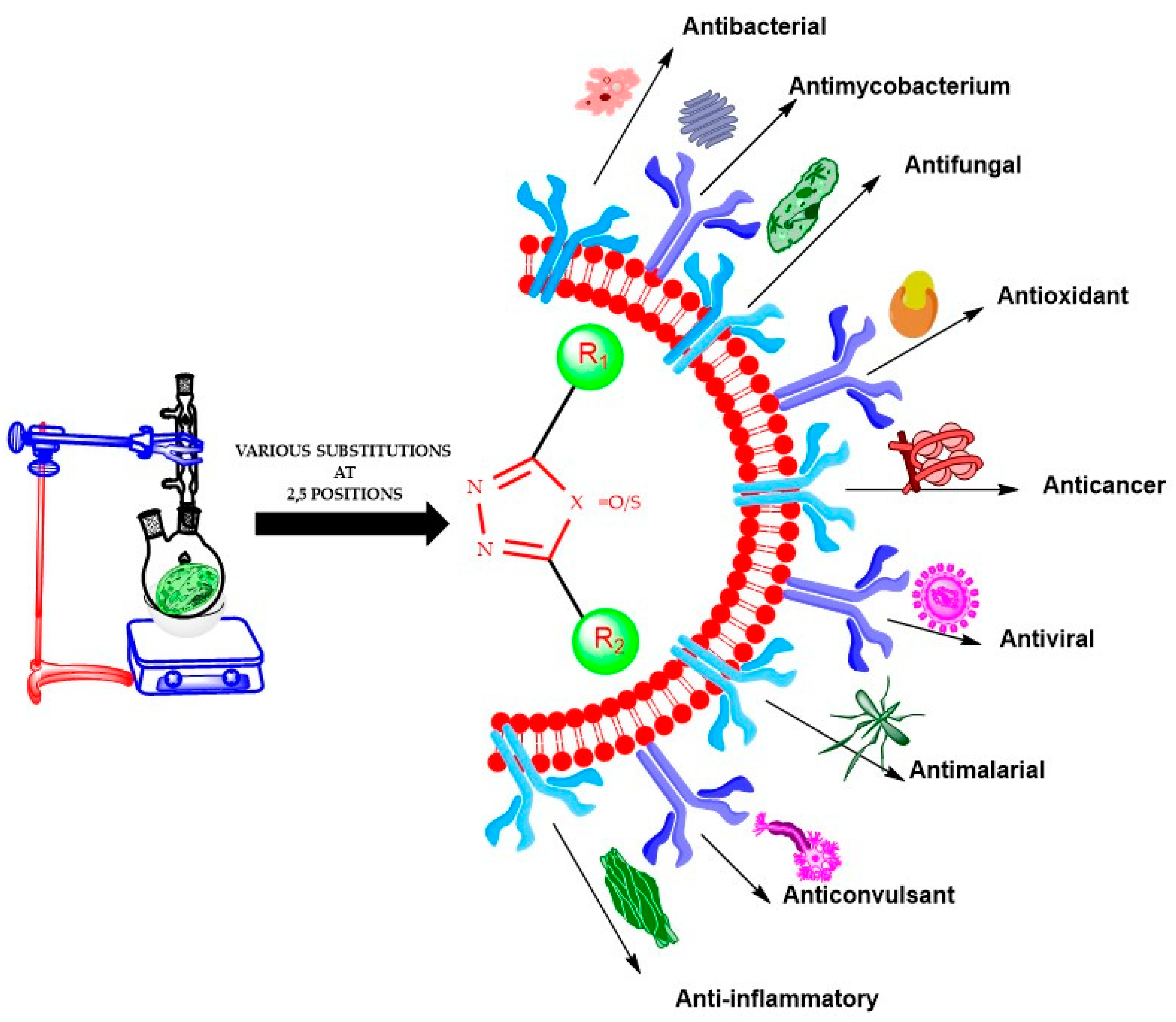
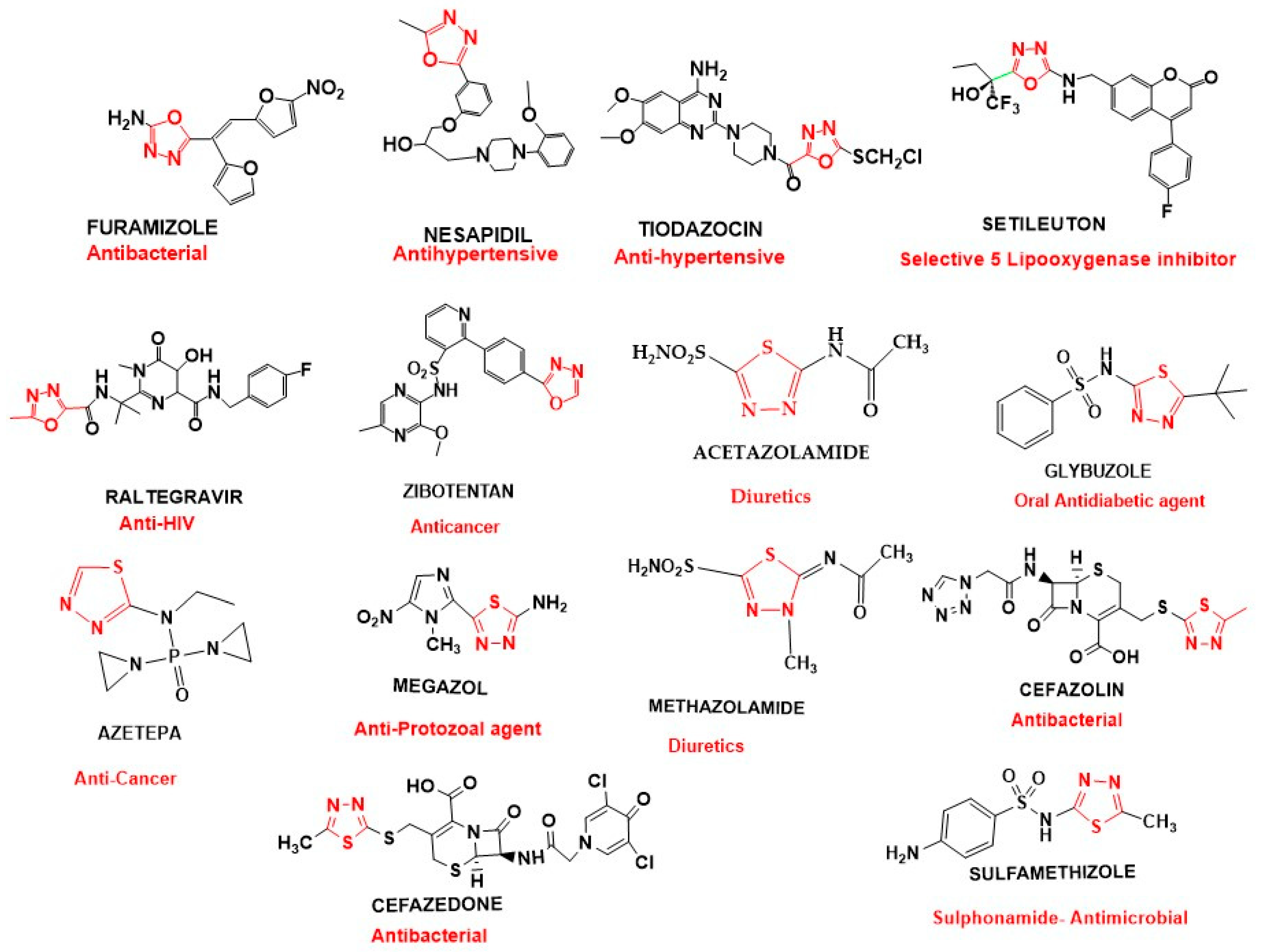
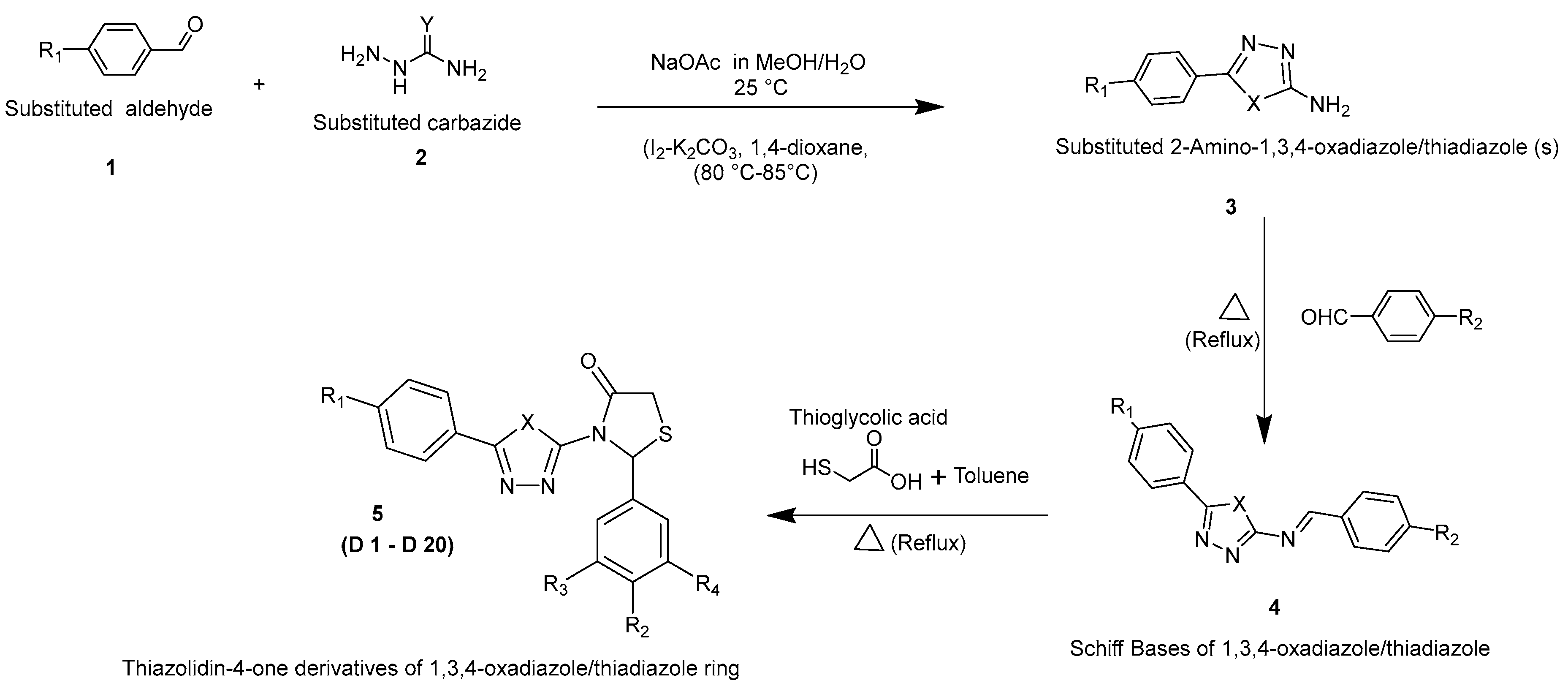
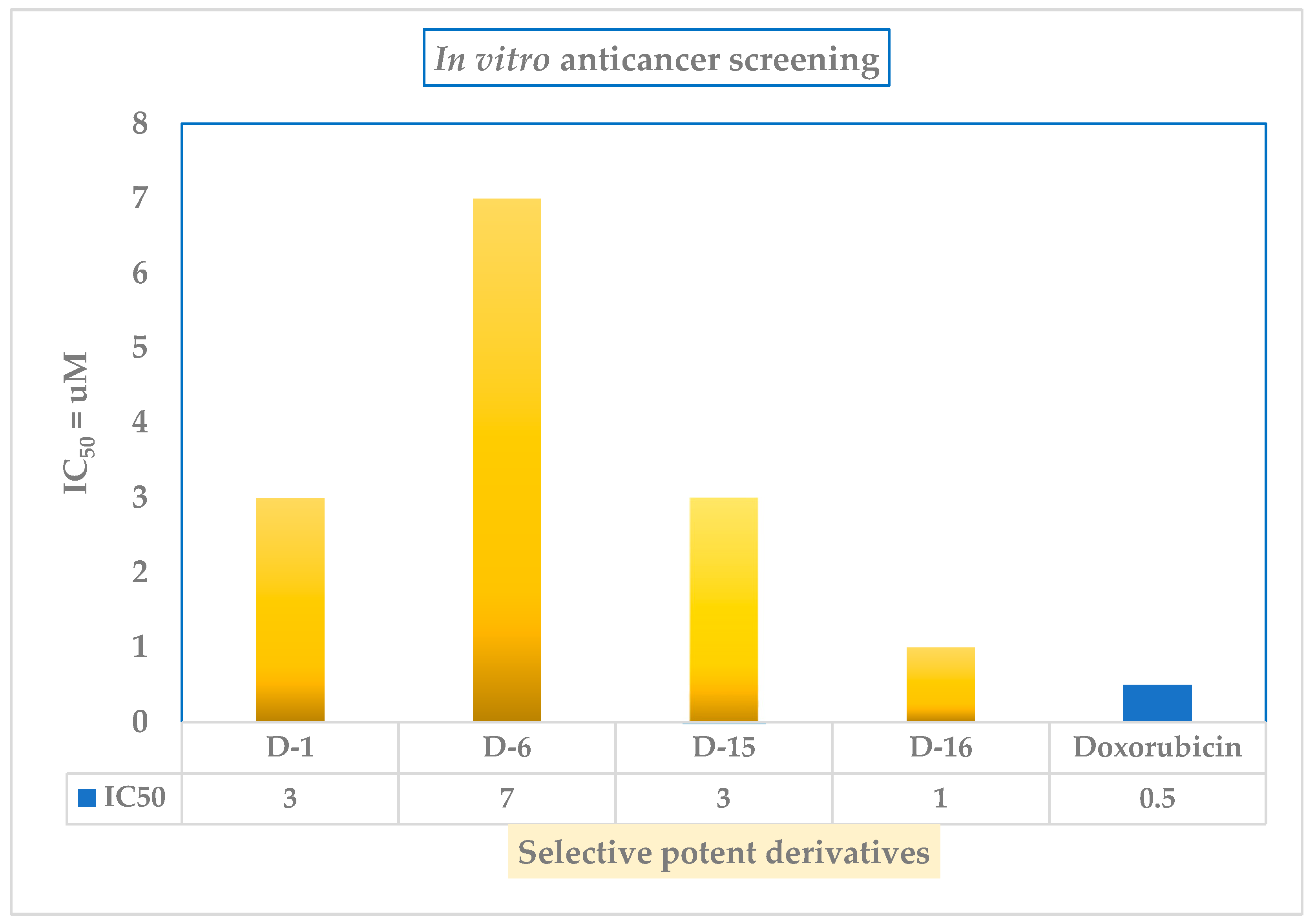

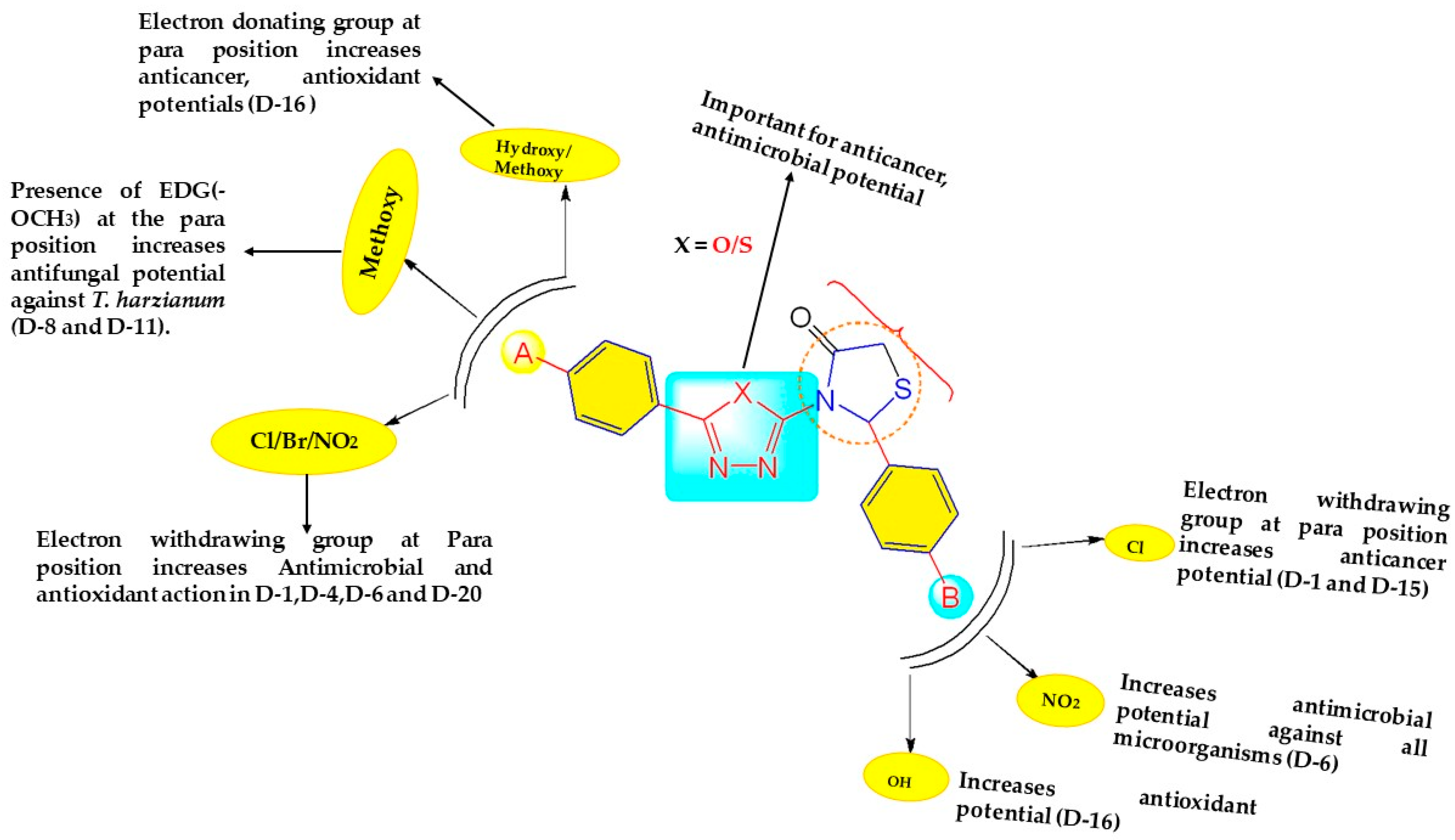
| S. No. | Derivative (5) | Y (2) | X | R1 | R2 | R3 | R4 |
|---|---|---|---|---|---|---|---|
| 1. | D-1 | O | O | NO2 | Cl | H | H |
| 2. | D-2 | O | O | NO2 | NO2 | H | H |
| 3. | D-3 | O | O | NO2 | OH | H | H |
| 4. | D-4 | O | O | Cl | Br | H | H |
| 5. | D-5 | O | O | Cl | OCH3 | H | H |
| 6. | D-6 | O | O | Cl | NO2 | H | H |
| 7. | D-7 | O | O | Cl | Cl | H | H |
| 8. | D-8 | O | O | OCH3 | OCH3 | H | H |
| 9. | D-9 | O | O | OCH3 | H | Cl | Cl |
| 10. | D-10 | O | O | OCH3 | NO2 | H | H |
| 11. | D-11 | O | O | OCH3 | NH2 | H | H |
| 12. | D-12 | O | O | Cl | OH | H | H |
| 13. | D-13 | O | O | Cl | NH2 | H | H |
| 14. | D-14 | O | O | NO2 | I | H | H |
| 15. | D-15 | O | O | Cl | H | H | H |
| 16. | D-16 | S | S | OCH3 | OH | H | H |
| 17. | D-17 | S | S | Br | OH | H | H |
| 18. | D-18 | S | S | OCH3 | OCH3 | H | H |
| 19. | D-19 | S | S | OCH3 | Br | H | H |
| 20. | D-20 | S | S | Br | Cl | H | H |
| Antimicrobial Screening (MIC = µM) | |||||||
|---|---|---|---|---|---|---|---|
| Derivative | Antibacterial Screening | Antifungal Screening | |||||
| SA | EF | PA | EC | KP | TH | AN | |
| D-1 | 31.09 | 15.55 | 15.55 | 31.09 | 15.55 | 15.55 | 31.09 |
| D-2 | 7.55 | 7.55 | 15.13 | 7.55 | 7.55 | 15.13 | 15.13 |
| D-3 | 16.28 | 32.55 | 16.28 | 32.55 | 32.55 | 16.28 | 32.55 |
| D-4 | 7.16 | 3.58 | 7.16 | 7.16 | 7.16 | 14.33 | 7.16 |
| D-5 | 32.30 | 32.30 | 16.15 | 16.15 | 16.15 | 32.30 | 64.60 |
| D-6 | 7.76 | 7.76 | 7.76 | 15.55 | 7.76 | 7.76 | 31.09 |
| D-7 | 31.89 | 31.89 | 31.89 | 31.89 | 31.89 | 15.94 | 31.89 |
| D-8 | 32.64 | 32.64 | 32.64 | 32.64 | 32.64 | 8.15 | 32.64 |
| D-9 | 59.24 | 29.62 | 29.62 | 59.24 | 14.81 | 29.62 | 29.62 |
| D-10 | 15.70 | 15.70 | 15.70 | 15.70 | 15.70 | 31.41 | 15.70 |
| D-11 | 16.98 | 16.98 | 16.98 | 16.98 | 16.98 | 8.48 | 16.98 |
| D-12 | 16.76 | 67.02 | 33.51 | 33.51 | 8.36 | 33.51 | 33.51 |
| D-13 | 33.60 | 67.20 | 33.60 | 33.60 | 33.60 | 33.60 | 67.20 |
| D-14 | 50.61 | 50.61 | 50.61 | 50.61 | 25.30 | 25.30 | 25.30 |
| D-15 | 70.03 | 35.01 | 35.01 | 35.01 | 35.01 | 35.01 | 8.74 |
| D-16 | 15.66 | 31.33 | 15.66 | 15.66 | 7.82 | 15.66 | 31.33 |
| D-17 | 7.19 | 14.40 | 14.40 | 28.80 | 7.19 | 28.80 | 28.80 |
| D-18 | 7.82 | 15.66 | 31.33 | 15.66 | 15.66 | 31.33 | 31.33 |
| D-19 | 6.96 | 13.95 | 6.96 | 13.95 | 13.95 | 13.95 | 27.90 |
| D-20 | 13.83 | 27.65 | 6.90 | 13.83 | 27.65 | 27.65 | 6.90 |
| Amoxicillin | 4.29 * | 4.29 * | 4.29 * | 4.29 * | 4.29 * | ||
| Fluconazole | 5.10 ** | 5.10 ** | |||||
| Derivative | IC50 (µM) |
|---|---|
| D-1 | 38.3 |
| D-2 | 84.3 |
| D-3 | 60.2 |
| D-4 | 70.6 |
| D-5 | 81.6 |
| D-6 | 39.5 |
| D-7 | 86.6 |
| D-8 | 74.2 |
| D-9 | 57.4 |
| D-10 | 90.2 |
| D-11 | 88.7 |
| D-12 | 101.1 |
| D-13 | 92.7 |
| D-14 | 79.2 |
| D-15 | 65.7 |
| D-16 | 22.3 |
| D-17 | 77.6 |
| D-18 | 73.7 |
| D-19 | 83.5 |
| D-20 | 70.5 |
| Ascorbic acid | 111.6 |
| Derivative | Physicochemical and Spectral Characteristics |
|---|---|
| D-1 | 2-(4-chlorophenyl)-3-(5-(4-nitrophenyl)-1,3,4-oxadiazol-2-yl) thiazolidin-4-one. Light yellowish color, M.pt. 180–182 °C, Rf value: 0.7*%, yield: 37%. Chemical formula: C17H11ClN4O4S. Molecular weight: 402. IR (KBr pellets) cm−1: 2926.14 (C-H str., aliphatic), 1732.18 (C=O str., thiazolidine ring), 1678.53 (C=N str., imine group), 1427.75 (C=C str., aromatic ring), 1602.13 (C=C str., methylene group), 1317.75 (C-N str., thiazolidine ring), 754.46 (C-Cl str., aromatic ring). 1H NMR (δ, DMSO):1.62–1.66 (m, 2H, 1,3-thiazolidin-4-one), 2.85–2.89 (m, 1H, 1,3-thiazolidin-4-one), 7.55–7.62 (m, 4H, aromatic H, incorporated with 1,3-thiazolidin-4-one) 7.85–7.87 (m, 4H, aromatic H, incorporated with 1,3,4-oxadiazole). m/z: 402.700. Elemental analysis (CHN) theoretical calc: C, 50.69; H, 2.75; N, 13.91; found: C, 50.60; H, 2.79; N, 13.96. |
| D-2 | 2-(4-nitrophenyl)-3-(5-(4-nitrophenyl)-1,3,4-oxadiazol-2-yl)thiazolidin-4-one. Orange color, M.pt. 175–177 °C, Rf value: 0.8*%, yield: 58%. Chemical formula: C17H11N5O6S. Molecular weight: 413. IR (KBr pellets) cm−1: 2984.07 (C-H str., aliphatic), 3070.31 (C-H str., aromatic), 1728.84 (C=O str., thiazolidine ring), 1650.74 (C=N str., imine group), 1464.21 (C=C str., aromatic ring), 1650.74 (C=C str., methylene group), 1500.11 (N-O str., nitro group), 1385.83 (C-N str., thiazolidine ring), 653.79 (C-S bend., thiazolidine ring). 1H NMR (δ, DMSO):2.15–2.29 (m, 2H, 1,3-thiazolidin-4-one), 3.06–3.25 (m, 1H, 1,3-thiazolidin-4-one), 7.21–7.22 (m, 4H, aromatic H, incorporated with 1,3-thiazolidin-4-one) 7.43–7.52 (m, 4H, aromatic H, incorporated with 1,3,4-oxadiazole). m/z: 413.04. Elemental analysis (CHN) theoretical calc: C, 49.40; H, 2.68; N, 16.94; found: C, 49.50; H, 2.54; N, 16.98. |
| D-3 | 2-(4-hydroxyphenyl)-3-(5-(4-nitrophenyl)-1,3,4-oxadiazol-2-yl)thiazolidin-4-one. White color, M.pt. 165–167 °C, Rf value: 0.7*%, yield: 44%. Chemical formula: C17H12N4O5S. Molecular weight: 384. IR (KBr pellets) cm−1: 2962.12 (C-H str., aliphatic), 3243.04 (C-H str., aromatic), 1688.01 (C=O str., thiazolidine ring), 1634.76 (C=N str., imine group), 1431.79 (C=C str., aromatic ring), 1597.91 (C=C str., methylene group), 1502.35 (N-O str., nitro group), 1371.40 (C-N str., thiazolidine ring), 1315.68 (OH str., aromatic ring), 673.86 (C-S bend., thiazolidine ring). 1H NMR (δ, DMSO):1.82–1.85 (m, 2H, 1,3-thiazolidin-4-one), 2.87–2.88 (m, 1H, 1,3-thiazolidin-4-one), 7.55–7.61 (m, 4H, aromatic H, incorporated with 1,3-thiazolidin-4-one) 7.85–7.87 (m, 4H, aromatic H, incorporated with 1,3,4-oxadiazole), 8.64 (s, 1H, aromatic OH). m/z: 384.05. Elemental analysis (CHN) theoretical calc: C, 53.12; H, 3.15; N, 14.58. Found: C, 53.02; H, 3.20; N, 14.63. |
| D-4 | 2-(4-bromophenyl)-3-(5-(4-chlorophenyl)-1,3,4-oxadiazol-2-yl)thiazolidin-4-one.White color, M.pt. 183–185 °C, Rf value: 0.7*%, yield: 49%. Chemical formula: C17H11BrClN3O2S. Molecular weight: 436. IR (KBr pellets) cm−1: 2986.68 (C-H str., aliphatic), 3041.69 (C-H str., aromatic), 1643.93 (C=O str., thiazolidine ring), 1426.27 (C=C str., aromatic ring), 1530.61 (C=C str., methylene group), 1340.36 (C-N str., thiazolidine ring), 596.93 (C-Br str., aromatic ring), 754.99 (C-Cl str., aromatic ring), 696.93 (C-S bend., thiazolidine ring), 710.85 (C-S bend., thiazolidine ring). 1H NMR (δ, DMSO):2.15–2.29 (m, 2H, 1,3-thiazolidin-4-one), 3.06–3.23 (m, 1H, 1,3-thiazolidin-4-one), 6.85–6.86 (m, 4H, aromatic H, incorporated with 1,3-thiazolidin-4-one) 7.43–7.51 (m, 4H, aromatic H, incorporated with 1,3,4-oxadiazole). m/z: 436.800. Elemental analysis (CHN) theoretical calc: C, 46.76; H, 2.54; N, 9.62. Found: C, 46.72; H, 2.60; N, 9.66. |
| D-5 | 3-(5-(4-chlorophenyl)-1,3,4-oxadiazol-2-yl)-2-(4-methoxyphenyl)thiazolidin-4-one.Green color, M.pt. 159–161 °C, Rf value: 0.8**%, yield: 61%. Chemical formula: C18H14ClN3O3S. Molecular weight: 387. IR (KBr pellets) cm−1: 2931.36 (C-H str., aliphatic of methoxy), 3381.33 (C-H str., aromatic), 1628.57 (C=O str., thiazolidine ring), 1427.89 (C=C str., aromatic ring), 1279.22 (C-N str., thiazolidine ring), 710.85 (C-Cl str., aromatic ring). 1H NMR (δ, DMSO):1.10 (s, 3H, OCH3, methoxyphenyl incorporated with 1,3,4-oxadiazole),1.72–1.74 (m, 2H, 1,3-thiazolidin-4-one), 2.51–2.53 (m, 1H, 1,3-thiazolidin-4-one), 4.54–4.55 (m, 4H, aromatic H, incorporated with 1,3-thiazolidin-4-one) 4.91–4.92 (m, 4H, aromatic H, incorporated with 1,3,4-oxadiazole). m/z: 387.700. Elemental analysis (CHN) theoretical calc: C, 55.74; H, 3.64; N, 10.83. Found: C, 55.54; H, 3.80; N, 10.87. |
| D-6 | 3-(5-(4-chlorophenyl)-1,3,4-oxadiazol-2-yl)-2-(4-nitrophenyl)thiazolidin-4-one. Orange color, M.pt. 199–201 °C, Rf value: 0.6*%, yield: 57%. Chemical formula: C17H11ClN4O4S, Molecular Weight: 402. IR (KBr pellets) cm−1: 3005.81 (C-H str., aromatic), 1604.43 (C=O str., thiazolidine ring), 1454.67 (C=C str., aromatic ring), 1513.94 (N-O str., nitro group), 1272.88 (C-N str., thiazolidine ring), 808.73 (C-Cl str., aromatic ring), 559.36 (C-S bend., thiazolidine ring). 1H NMR (δ, DMSO):2.15–2.29 (m, 2H, 1,3-thiazolidin-4-one), 3.06–3.23 (m, 1H, 1,3-thiazolidin-4-one), 6.85–7.01 (m, 4H, aromatic H, incorporated with 1,3-thiazolidin-4-one), 7.21–7.62 (m, 4H, aromatic H, incorporated with 1,3,4-oxadiazole). m/z: 402.020. Elemental analysis (CHN) theoretical calc: C, 50.69; H, 2.75; N, 13.91. Found: C, 50.75; H, 2.55; N, 14.05. |
| D-7 | 2-(4-chlorophenyl)-3-(5-(4-chlorophenyl)-1,3,4-oxadiazol-2-yl)thiazolidin-4-one. Brownish color, M.pt. 212–214°C, Rf value: 0.7*%: yield 32%. Chemical formula: C17H11Cl2N3O2S. Molecular weight: 392. IR (KBr pellets) cm−1: 3081.12 (C-H str., aromatic), 1661.11 (C=O str., thiazolidine ring), 1584.02 (C=C str., methylene group), 1499.76 (C=C str., aromatic ring), 1381.30 (C-N str., thiazolidine ring), 750.45 (C-Cl str., aromatic ring). 1H NMR (δ, DMSO):1.82–1.85 (m, 2H, 1,3-thiazolidin-4-one), 2.85–2.89 (m, 1H, 1,3-thiazolidin-4-one), 7.55–7.60 (m, 4H, aromatic H, incorporated with 1,3-thiazolidin-4-one), 7.85–7.87 (m, 4H, aromatic H, incorporated with 1,3,4-oxadiazole). m/z: 392.600. Elemental analysis (CHN) theoretical calc: C, 52.05; H, 2.83; N, 10.71. Found: C, 52.25; H, 2.70; N, 10.64. |
| D-8 | 2-(4-methoxyphenyl)-3-(5-(4-methoxyphenyl)-1,3,4-oxadiazol-2-yl) thiazolidin-4-one. Cream color, M.pt. 220–222 °C, Rf value: 0.7*%, yield: 72%. Chemical formula: C19H17N3O4S. Molecular weight: 383. IR (KBr pellets) cm−1: 2933.62 (C-H str., aliphatic), 3112.44 (C-H str., aromatic), 1663.37 (C=O str., thiazolidine ring), 1447.61 (C=C str., aromatic ring), 1481.90 (C=C str., methylene group), 1324.01 (C-N str., thiazolidine ring), 656.78 (C-S bend., thiazolidine ring). 1H NMR (δ, DMSO): 0.81 (s, 3H, OCH3, methoxyphenyl incorporated with 1,3-thiazolidin-4-one), 1.28 (s, 3H, OCH3, methoxyphenyl incorporated with 1,3,4-oxadiazole), 2.15–2.29 (m, 2H, 1,3-thiazolidin-4-one), 3.06–3.23 (m, 1H, 1,3-thiazolidin-4-one), 6.85–7.01 (m, 4H, aromatic H, incorporated with 1,3-thiazolidin-4-one), 7.22–7.62 (m, 4H, aromatic H, incorporated with 1,3,4-oxadiazole). m/z: 383.600. Elemental analysis (CHN) theoretical calc: C, 59.52; H, 4.47; N, 10.96. Found: C, 59.42; H, 4.50; N, 11.03. |
| D-9 | 2-(3,5-dichlorophenyl)-3-(5-(4-methoxyphenyl)-1,3,4-oxadiazol-2-yl)thiazolidin-4-one. White color, M.pt. 213–215 °C, Rf value: 0.8*%, yield: 63%. Chemical formula: C18H13Cl2N3O3S. Molecular weight: 422. IR (KBr pellets) cm−1: 3027.55 (C-H str., aromatic), 1673.58 (C=O str., thiazolidine ring), 1419.27 (C=C str., aromatic ring), 1485.15 (C=C str., methylene group), 1301.04 (C-N str., thiazolidine ring). 752.18 (C-Cl str., aromatic ring), 657.56 (C-S bend., thiazolidine ring). 1H NMR (δ, DMSO): 0.97 (s, 3H, OCH3, methoxyphenyl incorporated with 1,3-thiazolidin-4-one), 1.82–1.85 (m, 2H, 1,3-thiazolidin-4-one), 4.53–4.54 (m, 1H, 1,3-thiazolidin-4-one), 4.55–4.63 (m, 4H, aromatic H, incorporated with 1,3-thiazolidin-4-one), 4.64–4.93 (m, 4H, aromatic H, incorporated with 1,3,4-oxadiazole). m/z: 423.010. Elemental analysis (CHN) theoretical calc: C, 51.20; H, 3.10; N, 9.95. Found: C, 51.22; H, 3.12; N, 9.99. |
| D-10 | 3-(5-(4-methoxyphenyl)-1,3,4-oxadiazol-2-yl)-2-(4-nitrophenyl)thiazolidin-4-one. Pale yellowish color, M.pt. 207–209 °C, Rf value: 0.8*%, yield: 67%. Chemical formula: C18H14N4O5S. Molecular weight: 398. IR (KBr pellets) cm−1: 3088.63 (C-H str., aromatic), 1632.03 (C=O str., thiazolidine ring), 1515.85 (N-O str., nitro group), 1462.27 (C-H str., methoxy group), 1224.18 (C-N str., thiazolidine ring), 697.83 (C-S bend., thiazolidine ring). 1H NMR (δ, DMSO): δ 1.23 (s, 3H, OCH3, methoxyphenyl incorporated with 1,3-thiazolidin-4-one), 2.27–2.29 (m, 2H, 1,3-thiazolidin-4-one), 3.11–3.23 (m, 1H, 1,3-thiazolidin-4-one), 4.54–4.55 (m, 4H, aromatic H, incorporated with 1,3-thiazolidin-4-one), 4.91–4.92 (m, 4H, aromatic H, incorporated with 1,3,4-oxadiazole). m/z: 398.600. Elemental analysis (CHN) theoretical calc: C, 54.27; H, 3.54; N, 14.06. Found: C, 54.30; H, 3.51; N, 14.12. |
| D-11 | 2-(4-aminophenyl)-3-(5-(4-methoxyphenyl)-1,3,4-oxadiazol-2-yl)thiazolidin-4-one.Light green color, M.pt. 178–180 °C, Rf value: 0.6**%, yield: 49%. Chemical formula: C18H16N4O3S. Molecular weight: 368. IR (KBr pellets) cm−1: 2983.44 (C-H str., aliphatic), 3222.31 (C-H str., aromatic), 1686.04 (C=O str., thiazolidine ring), 1634.63 (N-H str., amine group), 1281.36 (C-N str., aromatic amine), 1122.07 (C-O str., oxadiazole ring), 700.14 (C-S bend., thiazolidine ring). 1H NMR (δ, DMSO): 1.49 (s, 3H, OCH3, methoxyphenyl incorporated with 1,3-thiazolidin-4-one), 2.85–2.89 (m, 2H, 1,3-thiazolidin-4-one), 4.53–4.55 (m, 1H, 1,3-thiazolidin-4-one), 4.62–4.65 (m, 4H, aromatic H, incorporated with 1,3-thiazolidin-4-one), 4.90–4.93 (m, 4H, aromatic H, incorporated with 1,3,4-oxadiazole), 8.30 (s, 2H, aromaticNH2). m/z: 368.120. Elemental analysis (CHN) theoretical calc: C, 58.68; H, 4.38; N, 15.21. Found: C, 58.08; H, 4.38; N, 15.81. |
| D-12 | 3-(5-(4-chlorophenyl)-1,3,4-oxadiazol-2-yl)-2-(4-hydroxyphenyl)thiazolidin-4-one. Green color, M.pt. 179–181 °C, Rf value: 0.7*%, yield 34%. Chemical formula: C17H12ClN3O3S. Molecular weight: 373. IR (KBr pellets) cm−1: 2971.65 (C-H str., aliphatic), 3230.37 (C-H str., aromatic), 1667.67 (C=O str., thiazolidine ring), 1628.07 (C=N str., imine group), 1440.28 (C=C str., aromatic ring), 1522.71 (C=C str., methylene group), 1291.32 (C-N str., thiazolidine ring), 1315.76 (OH str., aromatic ring), 770.93 (C-Cl str., aromatic ring), 697.66 (C-S bend., thiazolidine ring). 1H NMR (δ, DMSO): 2.15–2.28 (m, 2H, 1,3-thiazolidin-4-one), 3.11–3.23 (m, 1H, 1,3-thiazolidin-4-one), 6.85–6.86 (m, 4H, aromatic H, incorporated with 1,3-thiazolidin-4-one), 7.22–7.52 (m, 4H, aromatic H, incorporated with 1,3,4-oxadiazole), 9.43 (s, 1H, aromatic OH). m/z: 373.010. Elemental analysis (CHN) theoretical calc: C, 54.62; H, 3.24; N, 11.24. Found: C, 54.52; H, 3.20; N, 11.38. |
| D-13 | 2-(4-aminophenyl)-3-(5-(4-chlorophenyl)-1,3,4-oxadiazol-2-yl)thiazolidin-4-one.Yellowish, M.pt. 214–216 °C, Rf value: 0.6**%,yield: 56%. Chemical formula: C17H13ClN4O2S. Molecular weight: 372. IR (KBr pellets) cm−1: 3080.17 (C-H str., aromatic), 1661.01 (C=O str., thiazolidine ring), 1601.66 (N-H str., amine group), 1281.36 (C-N str., aromatic amine), 1132.84 (C-O str., oxadiazole ring). 750.99 (C-Cl str., aromatic ring). 1H NMR (δ, DMSO): 3.16–4.11 (m, 2H, 1,3-thiazolidin-4-one), 6.20 (s, 1H, 1,3-thiazolidin-4-one), 6.71–6.7 (m, 4H, aromatic H, incorporated with 1,3-thiazolidin-4-one), 7.8–8.3 (m, 4H, aromatic H, incorporated with 1,3,4-oxadiazole). m/z: 372. Elemental analysis (CHN) theoretical calc: C, 54.77; H, 3.51; N, 15.03. Found: C, 54.78; H, 3.60; N, 14.93. |
| D-14 | 2-(4-iodophenyl)-3-(5-(4-nitrophenyl)-1,3,4-oxadiazol-2-yl)thiazolidin-4-one.Reddish color, M.pt. 231–233 °C, Rf value: 0.7*%, yield: 64%. Chemical formula: C17H11IN4O4S. Molecular weight: 494. IR (KBr pellets) cm−1: 3143.30 (C-H str., aromatic), 1641.59 (C=O str., thiazolidine ring), 1596.32 (C=N str., imine group), 1464.32 (C=C str., aromatic ring), 1541.32 (C=C str., methylene group), 1263.59 (C-N str., thiazolidine ring), 1315.76 (OH str., aromatic ring), 622.37 (C-S bend., thiazolidine ring), 525.84 (C-I str., paraposition on aromatic ring). 1H NMR (δ, DMSO):3.66–4.13 (m, 2H, 1,3-thiazolidin-4-one), 6.38 (s, 1H, 1,3-thiazolidin-4-one), 7.27–7.28 (m, 4H, aromatic H, incorporated with 1,3-thiazolidin-4-one), 7.88–8.32 (m, 4H, aromatic H, incorporated with 1,3,4-oxadiazole). m/z: 493. Elemental analysis (CHN) theoretical calc: C, 41.31; H, 2.24; N, 11.34. Found: C, 41.28; H, 2.28; N, 11.35. |
| D-15 | 3-(5-(4-chlorophenyl)-1,3,4-oxadiazol-2-yl)-2-phenylthiazolidin-4-one.Brown color, M.pt. 217–219 °C, Rf value: 0.7*%, yield: 69%. Chemical formula: C17H12ClN3O2S. Molecular weight: 357. IR (KBr pellets) cm−1: 1735.50 (C=O str., thiazolidine ring), 1607.87 (N-H str., amine group), 1281.38 (C-N str., aromatic amine), 1173.11 (C-O str., oxadiazole ring). 1422.61 (C=C str., aromatic ring), 633.81 (C-S bend., thiazolidine ring). 1H NMR (δ, DMSO):3.70–4.10 (m, 2H, 1,3-thiazolidin-4-one), 6.18 (s, 1H, 1,3-thiazolidin-4-one), 7.32–7.47 (m, 5H, aromatic H, incorporated with 1,3-thiazolidin-4-one), 7.77–7.86 (m, 4H, aromatic H, incorporated with 1,3,4-oxadiazole). m/z: 357. Elemental analysis (CHN) theoretical calc: C, 57.07; H, 3.38; N, 11.74. Found: C, 57.17; H, 3.26; N, 11.76. |
| D-16 | 2-(4-hydroxyphenyl)-3-(5-(4-methoxyphenyl)-1,3,4-thiadiazol-2-yl)thiazolidin-4-one. Pale yellowish color, M.pt. 170–172 °C, Rf value: 0.6**%, yield: 43%. Chemical formula: C18H15N3O3S2.Molecular weight: 385. IR (KBr pellets) cm−1: 2993.78 (C-H str., aliphatic), 3040.45 (C-H str., aromatic), 1600.15 (C=O str., thiazolidine ring), 1474.64 (C=C str. aromatic ring), 1520.64 (C=C str., methylene group), 1338.03 (C-N str., thiazolidine ring), 650.39 (C-S bend., thiazolidine ring). 1H NMR (δ, DMSO): 3.82 (s, 3H, OCH3, methoxyphenyl incorporated with 1,3,4-thiadiazole), 3.58–3.66 (m, 2H, 1,3-thiazolidin-4-one), 6.33 (s, 1H, OH, incorporated with benzene), 6.74–7.76 (m, 2H, aromatic H, incorporated with 1,3-thiazolidin-4-one), 7.00–7.01 (m, 2H, aromatic H, incorporated with 1,3,4-oxadiazole), 7.063–7.078 (m, 4H, aromatic H, incorporated with 1,3,4-oxadiazole). m/z: 384.700. Elemental analysis (CHN) theoretical calc: 57.13; H, 4.29; N, 10.52. Found: C, 57.09; H, 4.27; N, 10.58. |
| D-17 | 3-(5-(4-bromophenyl)-1,3,4-thiadiazol-2-yl)-2-(4-hydroxyphenyl) thiazolidin-4-one.Light green, M.pt. 191–193°C, Rf value: 0.6**%,yield: 51%. Chemical formula: C17H12BrN3O2S2.Molecular weight: 434. IR (KBr pellets) cm−1: 1645.68 (C=O str., thiazolidine ring), 1456.99 (C=C str. aromatic ring), 1511.08 (C=C str., methylene group), 1246.43 (C-N str., thiazolidine ring), 1370.45 (OH str., aromatic ring), 665.42 (C-Br str., aromatic ring), 513.53 (C-S bend., thiazolidine ring). 1H NMR (δ, DMSO):3.63–3.67 (m, 2H, 1,3-thiazolidin-4-one), 3.54–3.61 (S, 1H, 1,3-thiazolidin-4-one), 6.67–6.77 (d, 4H, aromatic H, incorporated with 1,3-thiazolidin-4-one), 7.05–7.74 (d, 4H, aromatic H, incorporated with 1,3,4-oxadiazole), 7.57–7.59 (d, 2H, aromatic OH). m/z: 434.950. Elemental analysis (CHN) theoretical calc:C, 47.01; H, 2.79; N, 9.67. Found: C, 47.13; H, 2.70; N, 9.64. |
| D-18 | 2-(4-methoxyphenyl)-3-(5-(4-methoxyphenyl)-1,3,4-thiadiazol-2-yl) thiazolidin-4-one.White color, M.pt. 224–226 °C, Rf value: 0.6*%, yield: 57%. Chemical formula: C19H17N3O3S2. Molecular weight: 399. IR (KBr pellets) cm−1: 1630.66 (C=O str., thiazolidine ring), 1441.03 (C=C str. aromatic ring), 1533.52 (C=C str., methylene group), 1247.22 (C-N str., thiazolidine ring), 1209.10, 1355.60 (OH str., aromatic ring), 671.65 (C-S bend., thiazolidine ring). 1H NMR (δ, DMSO):3.79–3.80 (s, 3H, OCH3, methoxyphenyl incorporated with 1,3-thiazolidin-4-one), 3.60–3.67 (t, 2H, 1,3-thiazolidin-4-one), 6.42 (s, 1H, 1,3-thiazolidin-4-one), 3.79–3.80 (s, 3H, OCH3, methoxyphenyl incorporated with benzene ring), 6.87–6.89 (d, 4H, aromatic H, incorporated with 1,3-thiazolidin-4-one), 7.00–7.02 (m, 4H, aromatic H, incorporated with 1,3,4-oxadiazole). m/z: 399.070. Elemental analysis (CHN) theoretical calc: C, 57.13; H, 4.29; N, 10.52. Found: C, 57.01; H, 4.10; N, 11.10. |
| D-19 | 2-(4-bromophenyl)-3-(5-(4-methoxyphenyl)-1,3,4-thiadiazol-2-yl)thiazolidin-4-one.White color, M.pt. 236–238 °C, Rf value: 0.8*%, yield: 58%. Chemical formula: C18H14BrN3O2S2. Molecular weight: 448. IR (KBr pellets) cm−1: 2919.56 (C-H str., aliphatic), 1734.97 (C=O str., thiazolidine ring), 1463.83 (C=C str. aromatic ring), 1539.41 (C=C str., methylene group), 1335.34 (C-N str., thiazolidine ring), 1539.41 (C=N str., oxadiazole ring), 621.59 (C-S bend., thiazolidine ring), 586.59 (C-Br str., aromatic ring). 1H NMR (δ, DMSO):3.80(m, 3H, OCH3, methoxyphenyl incorporated with 1,3,4-oxadiazole), 3.54–3.60 (m, 2H, 1,3-thiazolidin-4-one), 6.41 (s, 1H, 1,3-thiazolidin-4-one), 7.38–7.48 (m, 4H, aromatic H, incorporated with 1,3-thiazolidin-4-one), 6.99–7.14 (m, 4H, aromatic H, incorporated with 1,3,4-oxadiazole). m/z: 440.600. Elemental analysis (CHN) theoretical calc: C, 48.22; H, 3.15; N, 9.37. Found: C, 48.42; H, 3.01; N, 9.31. |
| D-20 | 3-(5-(4-bromophenyl)-1,3,4-thiadiazol-2-yl)-2-(4-chlorophenyl)thiazolidin-4-one.Brown color, M.pt. 247–249 °C, Rf value: 0.7*%, yield: 72%. Chemical formula: C17H11BrClN3OS2.Molecular weight: 452. IR (KBr pellets) cm−1: 2922.29 (C-H str., aliphatic), 1737.33 (C=O str., thiazolidine ring), 1460.08 (C=C str. aromatic ring), 1368.40 (C-N str., thiazolidine ring), 1539.41 (C=N str., oxadiazole ring), 753.28 (C-Cl str., paraposition on aromatic ring), 551.85 (C-Br str., aromatic ring), 673.71 (C-S bend., thiazolidine ring). 1H NMR (δ, DMSO): 3.58–3.66 (m, 2H, 1,3-thiazolidin-4-one), 6.46 (s, 1H, 1,3-thiazolidin-4-one), 7.15–7.29 (m, 4H, aromatic H, incorporated with 1,3-thiazolidin-4-one), 7.40–7.59 (m, 4H, aromatic H, incorporated with 1,3,4-oxadiazole). m/z: 441.720. Elemental analysis (CHN) theoretical calc: C, 45.10; H, 2.45; N, 9.28. Found: C, 45.15; H, 2.42; N, 9.22. |
| TLC mobile phase (Rf) | “Ethyl acetate:petroleum ether (3:1)” *, “chloroform:methanol (7:3)” ** |
Disclaimer/Publisher’s Note: The statements, opinions and data contained in all publications are solely those of the individual author(s) and contributor(s) and not of MDPI and/or the editor(s). MDPI and/or the editor(s) disclaim responsibility for any injury to people or property resulting from any ideas, methods, instructions or products referred to in the content. |
© 2023 by the authors. Licensee MDPI, Basel, Switzerland. This article is an open access article distributed under the terms and conditions of the Creative Commons Attribution (CC BY) license (https://creativecommons.org/licenses/by/4.0/).
Share and Cite
Kumar, D.; Aggarwal, N.; Kumar, H.; Kapoor, G.; Deep, A.; Bibi, S.; Sharma, A.; Chopra, H.; Kumar Marwaha, R.; Alshammari, A.; et al. 2-Substituted-3-(5-Substituted-1,3,4-oxadiazol/thiadiazol-2-yl) Thiazolidin-4-one Derivatives: Synthesis, Anticancer, Antimicrobial, and Antioxidant Potential. Pharmaceuticals 2023, 16, 805. https://doi.org/10.3390/ph16060805
Kumar D, Aggarwal N, Kumar H, Kapoor G, Deep A, Bibi S, Sharma A, Chopra H, Kumar Marwaha R, Alshammari A, et al. 2-Substituted-3-(5-Substituted-1,3,4-oxadiazol/thiadiazol-2-yl) Thiazolidin-4-one Derivatives: Synthesis, Anticancer, Antimicrobial, and Antioxidant Potential. Pharmaceuticals. 2023; 16(6):805. https://doi.org/10.3390/ph16060805
Chicago/Turabian StyleKumar, Davinder, Navidha Aggarwal, Harsh Kumar, Garima Kapoor, Aakash Deep, Shabana Bibi, Aastha Sharma, Hitesh Chopra, Rakesh Kumar Marwaha, Abdulrahman Alshammari, and et al. 2023. "2-Substituted-3-(5-Substituted-1,3,4-oxadiazol/thiadiazol-2-yl) Thiazolidin-4-one Derivatives: Synthesis, Anticancer, Antimicrobial, and Antioxidant Potential" Pharmaceuticals 16, no. 6: 805. https://doi.org/10.3390/ph16060805
APA StyleKumar, D., Aggarwal, N., Kumar, H., Kapoor, G., Deep, A., Bibi, S., Sharma, A., Chopra, H., Kumar Marwaha, R., Alshammari, A., Alharbi, M., & Hayee, A. (2023). 2-Substituted-3-(5-Substituted-1,3,4-oxadiazol/thiadiazol-2-yl) Thiazolidin-4-one Derivatives: Synthesis, Anticancer, Antimicrobial, and Antioxidant Potential. Pharmaceuticals, 16(6), 805. https://doi.org/10.3390/ph16060805








